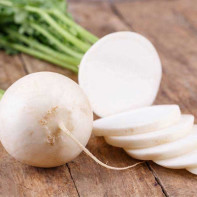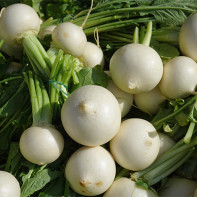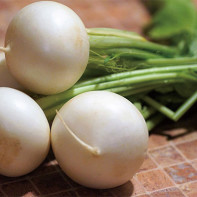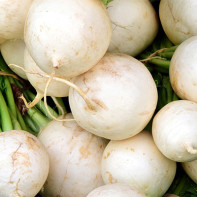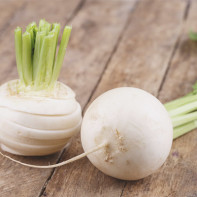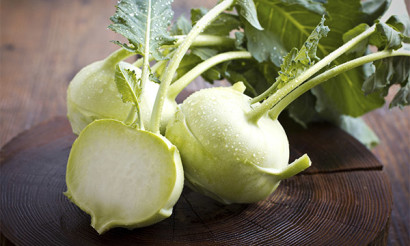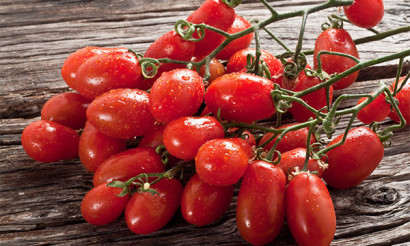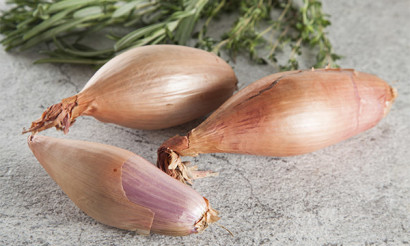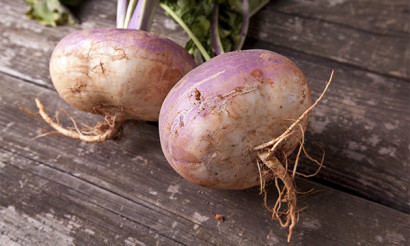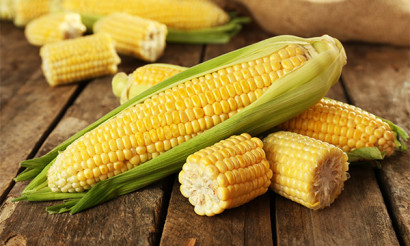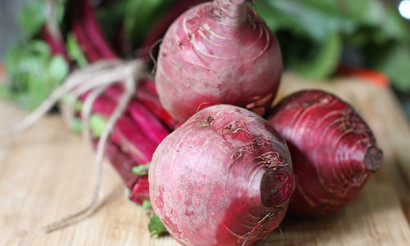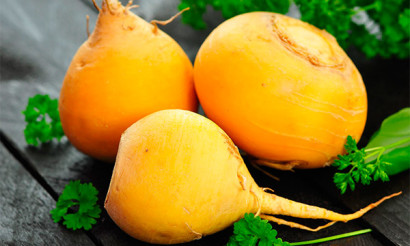White radish: useful properties and contraindications.
White radish is familiar to people since ancient times. In ancient Greece it was carried as an offering to the god Apollo. In many countries, from Latvia to Armenia, it was added to meat, made into salads and sweet dishes. In Russia, it was used as a cure for colds, pains, wounds, as a snack with a drink, as well as fried and used to make seasonings. Today, radishes are grown all over the world - in Europe, North America, Asia, and Australia. This article will describe the main properties of this product and its application.
- What is the difference between black radish and white radish
- Which is more useful
- Composition and calories
- Useful properties of white radish
- General benefits
- For Women
- For Men
- In Pregnancy
- Breastfeeding
- For children
- When losing weight
- White radish in folk medicine
- Cosmetic use
- Harm and Contraindications
- How to choose and store
- What can be cooked from white radish: Recipes
- Salads
- Garnishes
- Cocktails with daikon
- Diet / vegetarian meals
- Unusual dishes from white radish
- Interesting facts about radish
What is the difference between black radish and white radish?
Black radishes are common in Europe and America. The green one, first bred in Uzbekistan, is grown in Asia. Black radish has a dark skin and a completely white flesh inside, has a pungent taste and is very tough, so it is mainly used in salads, seasonings for meat dishes. Its main use is in cosmetics or medicines. Green radish has a green shade of skin and fruit, but its taste is much milder and not bitter. It is more often used in cooking, roasted, and made into chips.
In Japan, a special variety of radish - white radish, also known as daikon. It has a pleasant taste, is not bitter and contains the same set of vitamins and minerals as black and green radishes. In addition to taste, daikon is also distinguished by its unusual shape, its fruits are long and elongated.
Which is healthier
Of the three main varieties, the black radish is said to be the richest in beneficial substances. However, white radishes do not contain mustard oils, which give a pungent taste and have a strong effect on the stomach. Therefore, it is believed that the white radish is more useful for the body.
Composition and calories
White radish has only 20 kilocalories per 100 grams, which makes it popular among athletes, entertainers and people who lose weight. It has 13% dry matter, 8% carbohydrates and 3% protein.
White radish is unusually rich in vitamins and minerals. In 100 grams it contains:
- 30% of the daily allowance of vitamin C, which is a natural antioxidant and immune stimulant.
- Vitamin A, which has a beneficial effect on vision.
- B vitamins, which are useful for the absorption of sugars and generate enough energy for the body.
- Calcium, which is necessary for the formation and health of bone tissue and the nervous system.
- Magnesium and iron, which are necessary for the health of the circulatory system and circulatory organs.
- Sulfur, which helps produce the amino acids and vitamins the body needs.
- Phosphorus, important for joints.
- Other substances: iodine, pectin, fiber, enzymes.
Useful properties of white radish
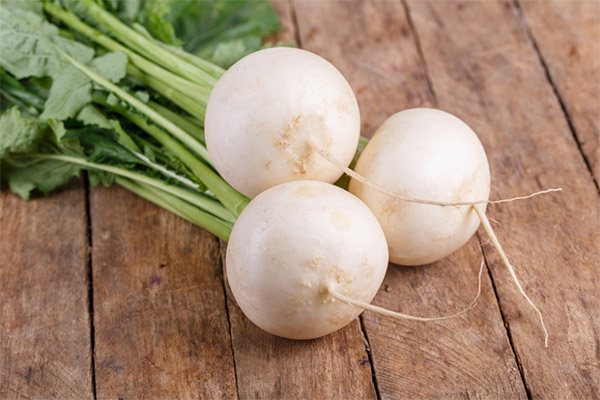
General Benefits
- When eaten, the most important property of radish is that it stimulates the digestive tract. Thanks to its spiciness, it accelerates the production of gastric juice and pancreatic enzymes. Fiber in white radish prevents the absorption of substances that produce cholesterol, which is dangerous for the cardiovascular system.
- Potassium salts in white radish contribute to the purification of the kidneys and liver, which prevents urolithiasis. Fiber stimulates the stomach and intestines, which helps cleanse the body.
- When consumed regularly, the vegetable helps strengthen the immune system due to its phytoncide and protein content, which destroys pathogenic flora in the body.
- White radish helps to reduce blood glucose and also contains fructose, so it can and should be consumed by those who suffer from diabetes.
- The fruit is used as a wound-healing agent and in acne remedies.
For women
White radish contains a lot of folic acid and thiamine. Because of this, it is unusually useful for women's health, including during pregnancy.
Calcium, which is rich in white radish, coming in sufficient quantities into the body of a woman, helps to strengthen bones and teeth, maintain a healthy appearance of hair. The low calorie content makes white radish a tasty and useful product for dietary meals. Use for cosmetic purposes helps maintain the beauty of the skin of the face.
For Men
- White radish supports the nervous system and helps those who often face stress, making it an important product for men.
- Thanks to the general tonic properties of white radish, regular use improves potency.
- For men engaged in sedentary work, the benefit of white radish is to improve the blood flow of the organs in which blood stagnates during prolonged sitting in one position.
In Pregnancy
White radish is useful for those who are expecting a baby. It has a diuretic effect and helps to fight swelling. Calcium in its composition helps the mother to strengthen teeth, hair and bones, and is also involved in the formation and development of the child's bone system. Contraindications should be discussed with the doctor supervising the pregnancy, he will suggest possible restrictions.
In rare cases, white radish can cause problems with the gastrointestinal tract, negatively affect the nervous system, causing irritability. In general, it is recommended to use no more than 100 grams of fresh white radish twice a week. In the last trimester you should refuse it at all.
When breastfeeding
There are no contraindications to the use of white radish during breastfeeding. Moreover, it can increase the production of milk. Whether to use the vegetable or not should be decided by the mother herself, based on her preferences and the reaction of the baby's body. If the baby has an allergic reaction or digestive problems when using white radish, the vegetable should be excluded from the diet.
For kids
Despite the fact that white radish has little mustard oil and is not bitter, children rarely like it. The vegetable has a high fiber content, which is difficult for a baby's body to digest. Therefore, you should start giving it to your child not earlier than after three years, and in small quantities.
For weight loss
White radish is often included in weight loss diets due to its low calorie content. As part of salads, boiled or steamed, it gives a feeling of fullness, but at the same time does not cause weight gain. White radish helps to remove water from the body and cleanse it of toxins and impurities, which is the key to success on the path to weight loss. Consumption of white radish helps to improve the metabolism and improve digestion.
White radish in traditional medicine
The useful properties of radishes have been known since ancient times, below are the recipes for the treatment and prevention of various diseases of traditional medicine.
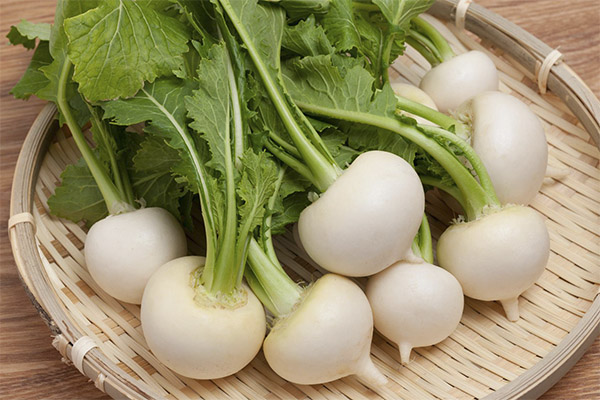
White radish is often used for colds, bronchitis, flu.
- A mixture of grated white radish and honey (1:1) is used to treat coughs. The mixture should be strained and infused for about 12 hours, and then take 1 tablespoon three times a day.
- Coughs can also be treated by eating baked radishes. Finely chopped radish (1-2 small fruits) mixed with sugar (100 grams), bake for one to two hours, then strain and drink the resulting juice twice a day by 1 tablespoon.
- To treat bronchitis use a grated mixture of horseradish and radish (1:1). It is rubbed on the chest of a patient. The best effect is achieved if after the massage with the radish mixture the patient takes a warming drink (milk with honey or raspberry jam).
There are also such recipes:
With neuralgia, sciatica, myositis, fresh radish juice is rubbed into the skin along the nerve.
With radiculitis and rheumatism, compresses of grated white radish are used. You can use both a compress consisting only of radish and its mixture with vodka (30 grams per 300 grams of fruit) and honey (50 grams per 300 grams of pulp).
Radish juice mixed with apple juice is useful in the treatment of vascular diseases of the heart.
Also the juice of daikon, 30-50 grams after meals, is recommended to reduce blood sugar. It is important to remember that freshly squeezed juice of white radish is stored in the refrigerator no more than three days in a container, tightly closed with a lid.
Daikon juice is often used as a natural mild laxative. Half a glass of juice of white radish before going to bed will help to establish digestion in 1-2 drinks.
Elderly people are recommended to use 100-150 grams of fresh white radish in salads or with juice to effectively prevent atherosclerosis.
To accelerate the healing of wounds, cuts and scratches, you can apply grated or thinly sliced daikon. Under no circumstances should you put a white radish to an open wound, this will cause irritation and inflammation. Wound-healing properties of radish should be used only after the crust appears on the wound.
White radish is used in the treatment of hypertension. The juice of white radish (three parts) mixed with the juice of carrots (1 part), beets (1 part) and horseradish (2 parts) is drunk three times a day for 30 ml.
White radish as part of a complex treatment is also an excellent remedy for the treatment and prevention of anemia. The juice of white radish (5 parts) mixed with the juice of beets (4 parts) and carrots (2 parts) insist in an oven at 160 degrees for 3-5 hours. When using the resulting mixture three times a day before meals for three months, the symptoms of anemia recede.
When using folk medicine recipes should always consult a physician beforehand, exercise caution - the dosage, the frequency of intake. It is necessary to immediately stop treatment if side effects or allergic reactions occur.
Cosmetic applications
White radish is not the most common ingredient in beauty products, but it is a universal helper for any skin type, at any age. It helps to narrow pores, remove oily shine, reduce rashes, whiten and improve complexion.
- Radish peel lotion causes the skin to flush, tones it and nourishes it, this remedy is excellent in mature age. Well-washed peels of 3-5 fruits insist in 100 grams of vodka. After a few days, the lotion can be applied once a day.
- Hair mask helps to reduce hair loss, stimulate hair growth, improve blood circulation to the scalp. Grate white radish into a fine pulp, squeeze excess juice and apply a thin layer to the scalp for 15 minutes, then rinse thoroughly.
- To even out the tone of the face, reduce pigment spots will help mask with white radish. On a pre-cleaned skin, apply a greasy nourishing cream, over it put slices of white radish. After half an hour wash your face. For this procedure you can use warm milk, which will remove the residues of the mask and moisturize the skin after the procedure.
- White radish mask with olive oil is used to rejuvenate the skin and reduce the number of wrinkles. Finely chopped fruit (50 grams), mix with oil and apply to the pre-cleaned skin for 10-15 minutes.
For skin prone to greasiness, vegetable oils and greasy cream should be replaced with aloe juice.
Harms and contraindications
White radish is not recommended for those who suffer from ulcer disease or colitis, as it irritates the tissues of the gastrointestinal tract. Excessive consumption of radish can harm even healthy people, so you should eat it with great caution.
Like other products with a high content of essential oils and high concentration of vitamins, white radish can cause allergic reactions, so before you start its regular use for therapeutic and preventive purposes, you should make sure that it does not cause adverse reactions.
How to choose and store
The fruits of white radish of the best quality should be strong, firm, with a pleasant aroma. The flesh of the fruit should be homogeneous, of the same shade. The presence of cracks, veins and black dots on the fruit suggests that they have either been stored for a long time, or not observed storage conditions. Such fruits have a lower content of useful substances, and the toxins produced when rotting begins can harm the body.
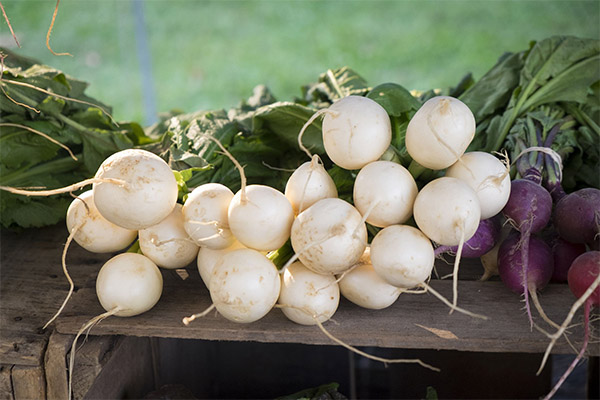
Daikon should be large enough, about 20 centimeters in length. Small fruits are unripe. Larger fruits often have a woody flavor and become too tough. The surface of the vegetable should be smooth, almost glossy. If the daikon is hard or rough, it indicates that the conditions of storage or transportation have been violated.
The color of white radishes should not have a gray or yellowish hue. Such fruits have an unpleasant taste. The tops of a tasty healthy fruit should also have a healthy appearance, being bright green in color.
You should not buy white radishes with signs of damage. Such fruits are stored for a very short time and may have an unpleasant taste.
If radishes grow in a homestead, it is important to pick them in cool weather, a week before cold weather. If you pick the fruit on dry, warm days, it will not keep for long. There should also be no rain when harvesting, and the fruit should be dry and clean to maximize its shelf life. Harvesting should also not be delayed too long. Even minimal frosts can harm the fruit, starting the processes of rotting.
Store the radish without the tops, after drying and cleaning from impurities. All fruits that have begun to spoil should be separated from the main mass. The best place to store radishes is the basement, where it is dark and cool. The optimal storage temperature is plus -3 degrees Celsius. You can also store radishes in the refrigerator at about zero or plus one degree. The shelf life of white radishes in the refrigerator is no more than two weeks.
Late varieties of radishes can be stored for six months or even more if the conditions are met.
What can be cooked from white radish: recipes
On sites dedicated to cooking, you can find many recipes with the addition of white radish. It is important to remember that when cooking with fresh radishes, they should stand. After 20 minutes, it does not affect the digestive system as much. If in the process of cooking the radish was removed from the skin, but then for some reason cooking was postponed, the fruit without the skin should be stored in the refrigerator in water.
When cooking with white radish, you can improvise, come up with your own dishes. However, you should remember about what products daikon combines best:
- The combination of white radish and fresh vegetables is classic. The vegetable can be an excellent base for salads of cucumbers, tomatoes, carrots, onions, garlic, cabbage.
- In the East, it is believed that fruit perfectly complements the bitter taste of radish. In the cuisine of the peoples of the East, you can often find recipes of white radish with pineapples, mangoes, apples, pears, oranges and even melons.
- Various nuts can be added to dishes with daikon, including peanuts, hazelnuts, almonds, pine nuts, as well as sunflower and sesame seeds.
- In the homeland of Daikon, Japan, it is often eaten with seafood. The aroma of white radish tones down the smell of fish or shellfish and complements their flavor. In Japan there are many recipes where daikon is used as a garnish with shrimp, fish, crabs and other seafood delicacies.
- Daikon combines well with meat, so it can be stewed with meat dishes, served as a side dish, and added to soups along with or instead of potatoes.
- In Japan, they often dry and salt daikon for the winter. In Russia it is also often used in preserves, but as part of salads.
Salads
- The most common is Vitamin salad. You need to mix 1 radish, 2-3 medium carrots, 1 green apple, 2 cloves of garlic, oil, sour cream or mayonnaise and salt to taste. In the Far East in such a salad is often added seaweed - kelp (half a small can of canned seaweed). And on the table is a salad that is especially useful to eat in the spring during the seasonal vitamin deficiency and in the fall, during the season of colds.
- Another simple and healthy salad consists of finely grated radish, garlic, parsley herbs and sour cream with salt. You can also add some grated horseradish to make it more spicy. This salad will decorate meat dishes and is great as an appetizer.
- The combination of the bright flavor of white radish and garlic with soft grated cheese and mayonnaise is a win-win for a quick salad. To do this, grate a small radish on a fine grater and mix it with 3 cloves of grated garlic and 150 grams of cheese. Dress the salad with mayonnaise or low-fat sour cream. It is better to choose soft varieties of cheese, without harsh flavors.
- Unusual salad with chicken and melon. For the salad you need 6 slices of melon, 1 small fruit of white radish, 1 cucumber, 2 chicken breasts, 50 grams of green onions, 30 grams of toasted walnuts, sesame oil, 1 tablespoon of honey, 2 tablespoons of peanut paste and soy sauce, 4 tablespoons of apple cider vinegar, 30 grams of fresh coriander. Grill or fry chicken fillets, cool and cut into small cubes or thin slices. The onion, cilantro, melon, cucumber and daikon slices. Mix all the ingredients of the salad with the dressing, leave for about 15 minutes and serve sprinkled with chopped walnuts.
Garnishes
- Garnish for meat and fish dishes, which can also be used as a separate dish: you need 1 radish (fruit daikon), celery stalk and 2-3 small turnips. Cut the fruit into medium-sized cubes and stew in a pan in vegetable oil for half an hour, adding 2-3 cloves of garlic and salt to taste.
- Pork with radish can diversify the usual meals and surprise guests or family with a pleasant taste. To prepare this recipe will require 300 grams of meat, 2 small radishes, 2 onions, 1 carrot, parsley, salt and pepper to taste. Fry the meat in a pan, then add the radish chopped into small cubes and stew for about an hour. Then add onions, carrots, herbs and spices, stew for another 15 minutes.
- Stewed radish. To prepare you will need 2 radishes, 300 grams of sour cream, 2 onions, salt, black pepper. Peel the radish, boil it until it becomes soft. Then fry onions in any vegetable oil in a pan. After 5-7 minutes add finely diced radish, sour cream and spices to the onion. Braise the resulting mixture for 15 minutes and serve as a separate dish or with rice, potatoes and other side dishes.
- Fried daikon and bacon. One large white radish, parsley and 200 grams of bacon fry in vegetable oil with pepper and salt to taste. Drain excess fat before serving. To eat during Lent, you can replace the bacon with onions.
- Battered daikon is a very simple recipe for a versatile side dish that will go with any dish. Fry the radish in flour in vegetable oil with salt and spices and serve with fish or meat dishes or on its own.
Cocktails with daikon
- Cocktail, widespread in Thailand, consists of a mixture of bell peppers, daikon, cucumber, (one piece each), basil and tarragon leaves, salt and water. Whisk the mixture of vegetables and water with a blender.
- Another version of the cocktail is with mango and apples. You will need 2-3 apples, 1 daikon, 2 tablespoons of lemon juice, 2 tablespoons of honey, a few mint leaves and 100-200 ml of water to make a tasty drink. You can use with the addition of green tea, sour milk or apple juice.
- Especially useful for men is a cocktail of daikon and celery. It consists of daikon, cucumber, celery, green apple (1 piece each), lemon juice (2-3 tablespoons), parsley, water (100 ml) and salt (to taste).
- Cocktails and smoothies can be made not only vegetable, but also fruit. A simple recipe with pears: take 1 piece of daikon, one pear, 50 grams of spinach and 1 spoonful of lemon juice and honey each and whip.
Dietary/Vegetarian Meals.
- For weight loss, it is recommended to consume 100-150 ml of fresh daikon juice daily. It can be drunk on its own or added to apple, orange and other juices.
- Complex, but unusually healthy and low-calorie salad: 300 grams of white radish, 150 grams of fresh cucumbers, carrots, beets, green apples, carrots grate on a coarse grater, mix with 50 grams of onions, 1 clove of garlic, 30 grams of parsley and dress with vegetable oil. To intensify the flavor and give more aroma in the salad, you can add a little salt and a taste of ground black pepper.
- Pickled daikon can be used to decorate rice or cooked vegetables. To prepare it, take 1 kilogram of daikon, 0.5 liter of water, 3 tablespoons of 9% vinegar, 4 tablespoons sugar, 1 tablespoon turmeric, 3 tablespoons salt, 5 cloves of garlic, 4 cloves, 3 bay leaves, ground black pepper to taste. Cut the raw daikon into small slices or thin circles, mix with salt and leave for 15 minutes. To prepare the marinade, add sugar and spices, except garlic, to the water, bring the resulting mixture to a boil, then pour the vinegar into it and allow to cool. After that, add daikon, finely chopped garlic to the water mixture. Pickled daikon to infuse for at least 12 hours before use. Store pickled radish directly in the refrigerator, and no more than two weeks. It is also possible to prepare it for the winter.
Unusual dishes from white radish
- Dumplings. To prepare you will need dough (water-flour-salt), one small radish, onion, salt, allspice. The white radish is fried in a pan with onions and spices to taste until golden brown, and then added to the filling of the dumplings. The taste is similar to dumplings with potatoes, but more savory. Serve with chopped green onions and sour cream.
- In Korea there is a popular recipe for daikon pancakes. Mix grated daikon (1 piece) with flour (1 cup), salt, red and black pepper to taste, starch (1 tablespoon), lemon juice (1 tablespoon), egg (one piece). Fry in a pan until golden crust. Serve the finished pancakes with soy sauce.
Interesting facts about radish
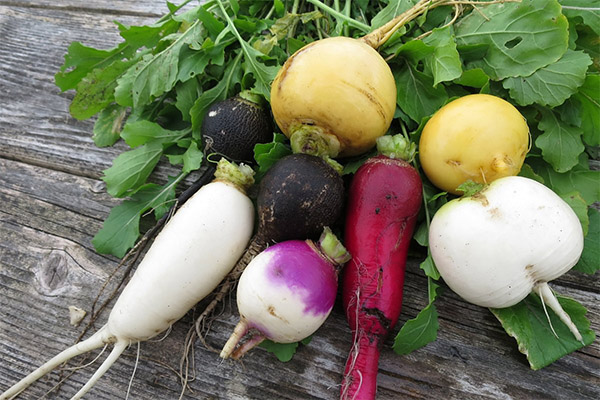
- In Russia, radish was called a "penitential vegetable", as it was one of the main foods during the days of Lent. House conditions did not allow cabbage, potatoes and other vegetables to be stored until the next harvest. Radish, thanks to its properties, is stored for a long time, so it was an essential part of the diet in the days when meat, milk and fish were prohibited.
- There is a variation of okroshka with radish. In Rus they often prepared a stew of kvass, boiled radish and potatoes. Dressed it with sour cream.
- In ancient Egypt, radishes were used to feed the builders of the pyramids. Workers were either enslaved or simply worked in harsh conditions, so the radish gave them strength and energy for hard physical labor.
- The largest variety of daikon, Sakurajima, can reach 50 cm in diameter and weigh up to 45 kilograms.
- Daikon is very popular among lovers of vegetable carving (carving). You can find many images of lotus, daisy and other flowers carved from white radish.
- Daikon greens are also very tasty and useful, but they are stored for a very short time, so their use is available only to those who grow white radish themselves on the homestead plot.
«Important: All information on this site is provided solely for introductory for educational purposes only. Before applying any recommendations, please consult with a specialist. specialist. Neither the editors nor the authors are liable for any possible harm caused by materials."

